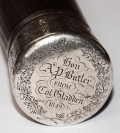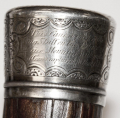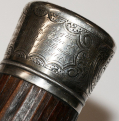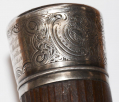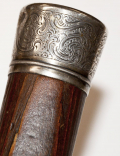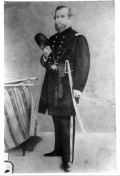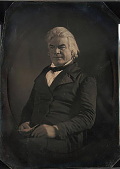site search
online catalog
HISTORICALLY SIGNIFICANT SILVER MOUNTED SOUTH CAROLINA PRESENTATION CANE

$6,800.00 SOLD
Quantity Available: None
Item Code: 715-35
Offered here is perhaps one of the most significant and historic relics we have had the pleasure to handle. It is not only of great importance to South Carolina history but to US history in general both military and political! The physical description of the cane is as follows: It measures 37 inches in length. The top mount is sterling silver, and the bottom is brass/bronze with a grounding iron. The wooden shaft is 33 inches long and is 1 1/2 inches wide at the top and tapers to about 3/4 of an inch. It is a hard wood, possibly oak. The ornate silver top cap is totally covered in decorative motifs and bears 2 inscriptions. The top inscription reads: " Hon. A.P. Butler from Col. Gladden 1849". Below this on the side of the sterling silver 1 1/4-inch cap one reads: "This Cane a part of the Flag Staff on the Palace of Mexico. Mounted with metal of Guns Captured in that City." One's eye then is directed to the 2 1/2-inch bronze/brass end cap made from those same cannons described as captured. Stamped on this brass piece is: " Peckham, Columbia, S.C." This is the mark of the Anti-Bellum silversmith James Peckham. The wooden hard wood flagpole now a cane is in excellent condition. Interestingly a few, possibly Spanish 1/4-inch-high letters (TIJIE?), can be see carved into the wood shaft, these interesting marks were left intentionally by the craftsman Peckham.
Regarding the presenter of the cane, he was Adley H. Gladden. He was born in South Carolina. A veteran of the Mexican War where he commanded the famous Palmetto Regiment of South Carolina volunteers. Initially Gladden was the major of that regiment, whose colonel and lieutenant-colonel were killed, leading to his advancement to colonel of the regiment. This regiment of volunteers bravely stormed of the Mexican works at the fierce Battle of Churubusco. In consequence of the deaths of the regiment's colonel and lieutenant colonel on that bloody day, Major Gladden became colonel of the Palmetto Regiment and led it in the attack on the Belen gate at the Battle of Mexico City, where he also was severely wounded.
When the Civil War began, Colonel Gladden, whose home was then in Louisiana, went to Pensacola, Florida as colonel of the First Louisiana regiment. On September 30, 1861, he was commissioned brigadier general CSA. He was in command of his brigade during the Union attack on Pensacola. In January 1862, Gladden was transferred to Mobile, Alabama and then to Corinth, Mississippi, where he was in command of a brigade composed of four Alabama regiments, the First Louisiana and Robertson's battery. At the Battle of Shiloh, Gladden was mortally wounded by a cannonball.
Regarding the presented who was the Honorable A. P. Butler a Jurist and U.S. senator. "Butler, the son of General William Butler and Behethland Foote Moore–both heroes of the Revolutionary War–was born on November 18, 1796, in Edgefield District. He was schooled first at Moses Waddel’s academy at Willington in Abbeville District and then at South Carolina College, from which he was graduated in 1817. On admission to the bar in 1819, Butler set up a law practice in Columbia. Soon after, he returned to Edgefield, where he maintained a lucrative legal practice and operated a plantation at his Stonelands estate. Butler, who owned one thousand acres and sixty-four slaves by 1850, owed much of his wealth and prestige to his distinguished lineage and his family’s position among the local elite. Butler’s first wife, Susan Anne Simkins, died on May 22, 1830, just months after their marriage. Two years later, in 1832, Butler wed Harriet Hayne. The couple had one child, daughter Eloise, before Harriet’s death in 1834. He never married again.
Butler also owed his early prominence and much of his later political influence to his friendship with John C. Calhoun. In 1824 Butler won election to the South Carolina General Assembly, representing Edgefield District in the S.C. House from 1824 to 1831 and in the S.C. Senate from 1832 to 1833. During his Senate tenure he became a staunch Calhoun ally in the nullification controversy, even raising a company of cavalry, the Edgefield Hussars, after President Andrew Jackson threatened to invade the state. His alliance with Calhoun probably forced Butler to appear more radical than he actually was, and it was only after Calhoun’s death that Butler’s relative moderation became apparent.
In 1833 Butler accepted an appointment as a state judge, serving on the bench until 1846. Contemporaries who described him as pleasing and congenial in person found that he could often be sour, short, and sarcastic on the bench, and opinions of his effectiveness varied from decisive and efficient to bored and disinterested. In 1846 he seemed to welcome the opportunity to fill one of South Carolina’s seats in the U.S. Senate, vacated by the resignation of George McDuffie. Partly due to Calhoun’s influence, he won that election and was reelected in 1848 and 1854.
Still in Calhoun’s shadow, Butler assumed the senior senator’s extreme sectional stance during what was a fiery era in American politics. Like Calhoun, he denied that the federal government had any power over slavery in the territories. He opposed the admission of California, which was poised to enter the Union as a free state and called for a stronger fugitive slave law. On Calhoun’s death in 1850, however, Butler subtly changed his position. As sectional controversy reached a crescendo that summer, Butler endorsed the Compromise of 1850. From then on, and even as fire-eaters at home were pushing for secession, his public remarks tended to decry sectional alienation and civil strife.
Despite his inclination toward compromise, Butler remained a staunch advocate of slavery and a critic of abolitionists’ agitation. In 1854 Butler supported the Kansas-Nebraska Act, which repealed the Missouri Compromise and instituted popular sovereignty in the Kansas territory. His support of Kansas-Nebraska and some well-placed barbs about abolitionists soon engaged him in a verbal duel with Senator Charles Sumner of Massachusetts. The two exchanged occasional caustic remarks for two years until, in May 1856, the quarrel blew up into one of the most notorious episodes of political violence in U.S. history.
Indeed, Butler is perhaps best remembered for his role in the affair–even though he was not present for one minute of it. On May 19 and 20, Sumner launched into a speech entitled “The Crime against Kansas.” His villain was Butler, who was absent. Butler was “the Don Quixote of slavery,” and his mistress in this morality play, “though ugly to others, is always lovely to him; though polluted in the sight of the world, is chaste in his sight . . . the harlot, Slavery.” Sumner then compounded the insult by mocking Butler’s habit of spitting when he spoke. On May 22, in an incident that some historians view as a critical turning point toward civil war, Butler’s cousin Preston S. Brooks avenged his kinsman by caning Sumner on the floor of the Senate. Sumner was incapacitated for three years; Butler, however, defended the act as necessary and honorable. Almost exactly a year later, on May 25, 1857, Butler died at his home in Edgefield."
To call this a museum piece would be an understatement! This is a piece of with significance for the Civil War collector, the Anti-Bellum Southern enthusiast, the collector of African Americana and those enthralled with political history. [pe] [ph:L]
~~~~~~~~~~~~~~~~~~~~~~~~~~~~~~~~~~~
THIS ITEM, AS WITH ALL OTHER ITEMS AVAILABLE ON OUR WEB SITE,
MAY BE PURCHASED THROUGH OUR LAYAWAY PROGRAM.
CLICK HERE FOR OUR POLICIES AND TERMS.
THANK YOU!
Inquire About HISTORICALLY SIGNIFICANT SILVER MOUNTED SOUTH CAROLINA PRESENTATION CANE
For inquiries, please email us at [email protected]
Most Popular
Historical Firearms Stolen From The National Civil War Museum In Harrisburg, Pa »
Theft From Gravesite Of Gen. John Reynolds »
Cavalry Carbine Sling Swivel »
Fine Condition Brass Infantry Bugle Insignia »
featured item
CONFEDERATE FIRST NATIONAL FLAG FROM ISLAND NUMBER TEN
This Confederate First National flag has a tight provenance going back to 1935, and before that an oral history as a war souvenir brought back from Island Number Ten by James William McLaughlin, a prominent Cincinnati architect who in 1861 had served… (1179-004). Learn More »




